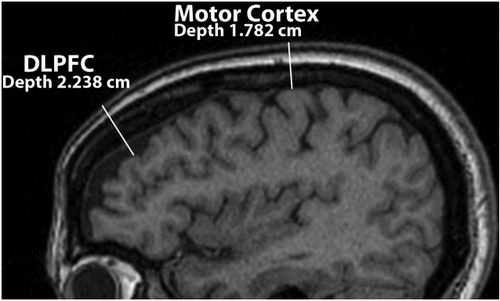Should We Consider the Depth of the Cortex for the Use of rTMS?
To the Editor: Repetitive Transcranial Magnetic Stimulation (rTMS) is known to have therapeutic effects in Treatment Resistant Depression (TRD) when it is applied over the dorsolateral prefrontal cortex (DLPFC).1 However, its therapeutic effects remain modest and thus factors that attenuate the effects of rTMS in the brain should be identified. The depth of the cortex, which is never considered for the use of rTMS, might explain why rTMS therapy sometimes fails.
Case Report
A 43-year-old woman, suffering from TRD lasting for 10 years, was referred to our department for rTMS therapy. The patient presented a history of asymptomatic moderate prefrontal atrophy, confirmed by a recent neurological evaluation including neuropsychological tests that excluded fronto-temporal dementia.
We decided to deliver low- frequency (1 Hz) rTMS over the right DLPFC (360 pulses per session) using a Figure 8 coil. We used a 120% resting Motor Threshold (MT), one of the highest recommended intensities.1 MRI-based neuronavigation was used to localize the DLPFC. We assessed rTMS efficacy using the Hamilton and the Montgomery Asberg Depression Rating Scale (HDRS, MADRS).
The patient received 10 sessions over 2 weeks, but showed no significant improvement assessed by the two scales (HDRS: 35 to 32; MADRS: 34 to 33). Four weeks later, an additional 10 sessions were given over 2 weeks. Once again, the treatment proved to be ineffective (HDRS: 33 to 30; MADRS: 33 to 25). We decided to stop rTMS therapy after 6 additional sessions that also proved to be ineffective.
Discussion
rTMS therapy aims to induce depolarization of the cortex located just below the stimulation coil thanks to a magnetic field.2 The intensity of the stimulation to deliver to the DLPFC is determined by measuring the MT. The MT is defined by the electric charge required to induce a muscle response.1
But the distance from the scalp to the DLPFC may be greater than the distance from the scalp to the motor cortex as in the present case (Figure 1). Since the magnetic field decreases dramatically with distance from the source, we were unable to confirm that DLPFC neurons were activated in this case.3

By way of illustration, we used an electric charge of 94 A/ms to stimulate the DLPFC (120% MT) in our patient, in whom the distance from the scalp to the motor cortex was 1.8 cm whereas that to the DLPFC was 2.2 cm. When we placed the coil over the motor cortex at a distance of 2.2 cm with electric charge at 94 A/ms, we found that we were unable to induce a motor response in the contralateral muscles. In fact, the electric charge required to reach the MT in our patient at this distance from the motor cortex was 125 A/ms. This value is so high that it was impossible to treat the patient using 120% MT, because it would have required 100.8% of the stimulator’s power.
Brain anatomy including variations in the depth of the cortex may be an important factor for the efficacy of TMS therapy.
1 ;
2 : Repetitive transcranial magnetic stimulation for major depressive disorder: a review. Can J Psychiatry 2008; 53:555–566Crossref, Medline, Google Scholar
3 : Transcranial magnetic stimulation of deep brain regions: evidence for efficacy of the H-coil. Clin Neurophysiol 2005; 116:775–779Crossref, Medline, Google Scholar



